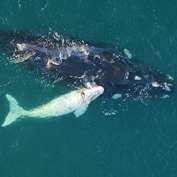Whale study using drones and tags captures aerial footage of white whale calf

Researchers from Murdoch University's Cetacean Research Unit (MUCRU) have recorded extraordinary video footage of a rare white southern right whale calf off the coast of Western Australia.
The drone footage was taken off Augusta in south west Australia by Murdoch University researchers Dr Fredrik Christiansen and Professor Lars Bejder. They are leading a collaborative research project with Professor Peter T. Madsen, from Aarhus University in Denmark, using a ground-breaking approach to help unlock some of the mysteries surrounding the whales.
The research team is using a suite of innovative technologies including suction cup tags and drones to assess fine-scale movements, acoustic communications, ambient noise, calf suckling rates and body condition of southern right whales. In doing so, Professor Bejder said the team hopes to better understand the behaviours of the whales in their breeding and calving grounds, and how human activities may influence behavioural patterns, including suckling rates of calves.
"Little is known about the three dimensional movements and habitat-use of southern right whales in their breeding and calving grounds in Australia – many of which are slated for development activity, including associated increases in shipping, marine tourism and recreational activity. Our aim is not only to study the behavioural ecology of these amazing animals, but also to provide information to industry and management towards conservation," said Professor Bejder.
"We need to know more about the ambient ocean noise in these regions and the extent to which southern right whales will be exposed to increased noise from human activity."
Drones were flown over the whales and their calves, gathering valuable video footage and images which enables the researchers to measure and assess their body size and health.
"Drones are allowing us to non-invasively measure the size and body condition of free living southern right whales, which in turn allows us to investigate important aspects of their health and reproduction, including the growth rate of calves in relation to the condition of their mothers," said Dr Christiansen.
By approaching the whales slowly in a small vessel and using hand-held poles, digital acoustic recording tags (DTAGs) were attached to seven whales in a manner that minimises the potential for disturbance. The DTAGS were attached to whales for periods of up to 24 hours, sending back valuable data of their movements in three dimensions, vocal behaviour, calf suckling rates and the acoustic environment at 800 samples per second.
"The DTAG measures and records the depth, pitch and roll of swimming behaviour in three-dimensions of the tagged animal. The tag also records sound, which is sufficient for measuring sounds made by boats and those heard by the whales," added Professor Bejder.
The DTAG also contains a VHF transmitter that is used to follow the tagged whale whenever it is at the surface and to aid in tag retrieval. A programmable release mechanism allows tags to release at a predetermined time.
The information acquired will aid management agencies at a federal and state level in developing conservation strategies to protect southern right whales in areas of proposed coastal development and increasing human activity.
All research activities were permitted by the WA Department of Parks and Wildlife and Murdoch University Animal Ethics Committee and all drone operations were conducted in accordance with CASA regulations.
Provided by Murdoch University





















